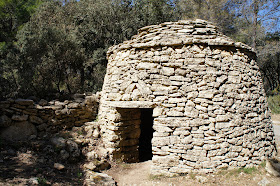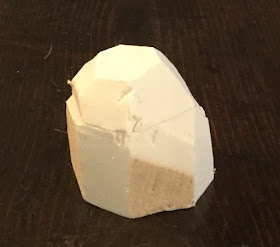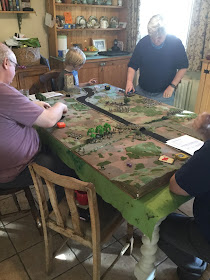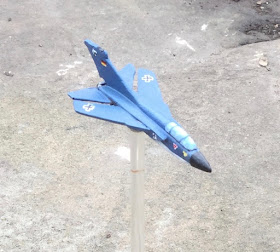Saturday saw the first game proper of my attempt to follow the Borsetshire Regiment through the Peninsular War. I'm regarding
the Obidos action as having been a rules teaching session.
Our action took place on 21st August 1808 near the Portuguese village of Vimeiro. There, Sir Arthur Wellesley is holding a defensive position along a reverse-L-shaped line of hills. He is under attack by the army of Marshal Jean-Andoche Junot. Junot has attempted to outflank Wellesley by sending troops to attack the left flank of the British position on the north-south ridge.
Wellesley reacts by moving his troops north to reinforce the north-south ridge. Having an elevated position and the interior line he is able to respond quickly to Junot's move. So for so historical. However....
One of Wellesley's ADCs, Major Hector McLeod, was sent to make certain that a key bridge north of the British position had been destroyed as per the general's instructions.
 |
Situation at Vimeiro after Wellesley had shifted
his right flank forces to the north-south ridge. |
Finding the bridge intact and no sign of the engineers sent to destroy it, McLeod hurried back to the British lines and commandeered the first troops he could find to defend the threatened sector. These just happened to be the light company of the Borsetshires and some soldiers of the 95th Rifles.
Meanwhile, Captain Etienne Choufleur of the 11eme Hussards had also discovered the unguarded bridge and dashed off to gather whatever troops he could find to force the bridge and win eternal glory!
Our table looked like this:
The north is at the far end so this photograph shows a bird's-eye view from above the French forces attacking Wellesley's left.
The river was passable at the bridge, obviously, but I allowed for certain river sections to be fordable on a roll of 6 on an ordinary die. The French ended up deploying near the curve of the river in the north but unluckily none of the three possible fording locations at that end of the battlefield proved to be practicable. This led the French with no alternative but the march to the bridge.
The French had:
One group of hussars under Choufleur
One group of dragoons under Lt Delaborde
Five groups of line infantry under Lt Duval, and
Two groups of voltigeurs under Lt Maurice.
The also had a fixed secondary deployment point, an ammunition wagon and a musician, though none of these played a significant role in the action.
McLeod's scratch force happened to enter closer to the bridge. He had:
Four groups of light infantry in line, and
Three groups of 95th Rifles skirmishers.
He was assisted by the officers of the Light Company of whom Lieutenants Villiers and Rogerson played a significant role in the action (i.e. were represented as leaders in the game) and by Lt Smythe of the Rifles.
 |
| The head of the British column arrives. |
The fighting began with an exchange of fire across a ford that the British had found immediately to the north of the bridge.
The results went significantly to the advantage of the French. Although Sgt Leblanc of the Voltigeurs was slightly wounded, his men killed three of the Riflemen at the ford in the first volley!
The French now spent some time getting their forces into position to assault the bridge. Lt Delabord's dragoons moved to a position on the extreme left of the French attack but they did so without any noticeable spring in their step.
With the French rather dawdling in their approach march, McLeod was able to form a line to defend the bridge.
With time running short, Major Choufleur determined that the only way to force the issue was to lead his hussars in a death-or-glory charge across the ford and onto the flank of the British line.
The attack as successful, though not brilliantly so. The left of the British line fell back in confusion with the beastly Lt Rogerson falling wounded to the ground. His men were disinclined to assist and left him to the mercy of the French.
At this point time beat us. Rolls on the relevant table had been such that very few points of Force Morale had been lost by either side so the action could well have gone on for another hour or so but family commitments didn't allow that.
The order of card play in the next turn would probably have been crucial. If the British got a couple of command cards early, Smythe's Rifles in the tree-line would have used Sharp Practice to reload and then hoped to pour fire into the hussars before the latter could rally off the shock they had accumulated in the recent fisticuffs.
Given that Wellesley didn't have his flank turned at Vimeiro, we must assume that some deus ex machina intervened and that Choufleur was not ultimately successful in forcing the issue on this occasion. He will return, however, to plague the Borsetshires in the future.
The fate of Lt Rogerson remains to be discovered but few will mourn his absence from the Regimental mess this evening.
Thanks are due to Kevin, Phil, Andy and Arthur for their staunch efforts in fighting this action.






















































